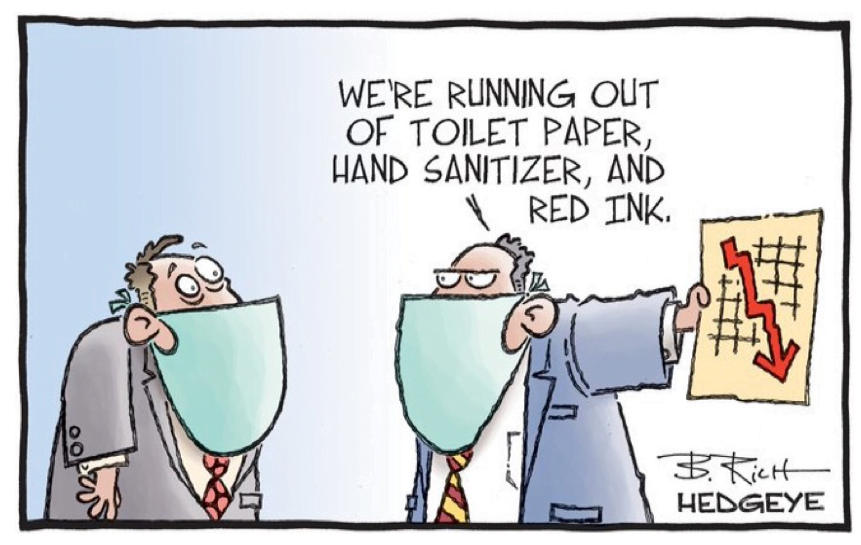Here’s the news of the week – and how we see it here at McAlvany Wealth Management:
Liquidity-Driven Growth and the Prospects for Gold
 It is difficult to reconcile what is happening in the capital markets with what is happening in the real economy. Today, we learned that there were 20.5 million jobs lost in the United States in the month of April. The unemployment rate has spiked to 14.7 percent, levels that we have not seen since the Great Depression. It seems like there is at least one retailer a day filing for Chapter 11 bankruptcy as discretionary spending falls off of a cliff. In fact, as of a week ago, consumers everywhere have pulled back, not just because they are going out and travelling less, but because they have very little visibility as to how their jobs and livelihoods are likely to be impacted by COVID-19. Earnings estimates continue to come down across industries and companies. Although we are seeing “reopenings” and a loosening of restrictions in many states, the response has been muted. People are fearful. Further, businesses struggle with how to accommodate new social distancing realities while maintaining any semblance of profitability.
It is difficult to reconcile what is happening in the capital markets with what is happening in the real economy. Today, we learned that there were 20.5 million jobs lost in the United States in the month of April. The unemployment rate has spiked to 14.7 percent, levels that we have not seen since the Great Depression. It seems like there is at least one retailer a day filing for Chapter 11 bankruptcy as discretionary spending falls off of a cliff. In fact, as of a week ago, consumers everywhere have pulled back, not just because they are going out and travelling less, but because they have very little visibility as to how their jobs and livelihoods are likely to be impacted by COVID-19. Earnings estimates continue to come down across industries and companies. Although we are seeing “reopenings” and a loosening of restrictions in many states, the response has been muted. People are fearful. Further, businesses struggle with how to accommodate new social distancing realities while maintaining any semblance of profitability.
This is in complete juxtaposition with the capital market environment, which is seemingly completely divorced from reality. Since the lows on March 23, the S&P 500 Index is up 30.4 percent and is now down “only” 9.7 percent for the year. Credit spreads, or the cost to borrow versus the so-called risk-free rate of return, have narrowed considerably since the initial panic. Market volatility continues to fall. Given the carnage in the real economy, it is difficult to explain, particularly to those whose livelihoods have been devastated by the collapsing economy. The pundits and talking heads tell us that all of the data is backward looking and that the market is discounting what will happen several months from now. Many are counting on a “V-shaped” recovery. Many believe that once businesses are able to resume operations that they will be able to recover from the impact in short order. There is also conventional wisdom that suggests that the real economies and the financial economies are detached from one another.
Being the contrarians that we are, we offer an alternative explanation. While we don’t doubt the resiliency of the American spirit, both the Federal Reserve and Congress have acted swiftly and aggressively to provide tremendous liquidity in the form of monetary and fiscal relief to the economy. The Fed has announced plans to purchase both investment grade and junk bonds, and the degree to which the Fed balance sheet has already expanded is historic. There is even talk of getting Congress to allow the Fed to buy equities. Nothing is off the table when it comes to backstopping the economy and the capital markets. To fund fiscal programs, the budget deficit has ballooned, and, given shrinking payrolls, it is clear that much of this debt will have to be monetized. The rally has very little to do with fundamentals and everything to do with liquidity.
It is our belief that the backdrop is very favorable for gold and gold producers. While over the last month the NYSE Arca Gold BUGS Index is up 34.8 percent and gold is up 3.7 percent, we believe there is more to come given the necessity of dollar devaluation over the long-term. We think gold producers are particularly well positioned for this environment, although the constituency of what we would call quality companies is somewhat narrow in scope. Over the last decade, in large part, producing companies have shown increasing capital discipline and have in many cases favored returns over growth. Increasingly, returning some cash to shareholders via dividend policy is a theme. In addition, we think that the opportunities for (finally) demonstrating operating leverage are upon us. Although social distancing measures are a cost at mining companies, many, having had to shut down operations for weeks following the pandemic, have had the opportunity to look at costs from a bottom-up level, and often they are finding the ability to use technology to drive down operating costs and maintain lower workforce levels. Foreign exchange and input costs are also a tailwind. Despite being very extended in the near term, we believe the table is set for a longer-term investment opportunity in these stocks.
Best Regards,
David McAlvany
Chief Executive Officer
MWM LLC















